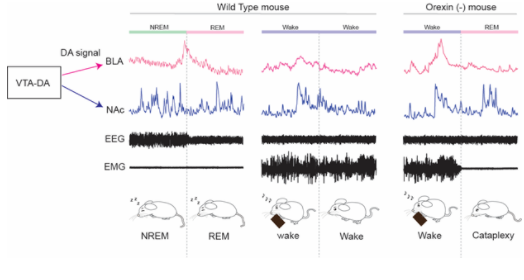・Transient dopamine elevation in the basolateral amygdala during NREM sleep plays an important role in triggering NREM-REM sleep transition.
・DRD2-expressing neurons in the basolateral amygdala activate the amygdala in response to dopamine, and this activation leads to REM sleep.
・Transient dopamine elevation in the basolateral amygdala during wakefulness is seen in narcoleptics, and plays an important role in triggering cataplexy.
Abstract
The sleep cycle is characterized by alternating non–rapid eye movement (NREM) and rapid eye movement (REM) sleeps. The mechanisms by which this cycle is generated are incompletely understood. We found that a transient increase of dopamine (DA) in the basolateral amygdala (BLA) during NREM sleep terminates NREM sleep and initiates REM sleep. DA acts on dopamine receptor D2 (Drd2)–expressing neurons in the BLA to induce the NREM-to-REM transition. This mechanism also plays a role in cataplectic attacks—a pathological intrusion of REM sleep into wakefulness—in narcoleptics. These results show a critical role of DA signaling in the BLA in initiating REM sleep and provide a neuronal basis for sleep cycle generation.
Benefit
This study has for the first time implicated the involvement of dopamine in the basolateral amygdala in the regulation of REM sleep. Similar mechanisms are also involved in cataplexy in narcoleptics. These findings provide new insights into control of both REM sleep and cataplexy by dopamine through D2 receptors.
Market Application
This work suggests that D2 receptor-expressing BLA neurons could be a selective druggable target for treating debilitating symptoms in REM sleep disorders, including cataplexy in narcolepsy. The findings may also have implications for the management of other disorders in which DA signaling is disrupted, such as Parkinson’s disease.
Publications
https://www.science.org/doi/pdf/10.1126/science.abl6618

